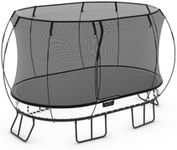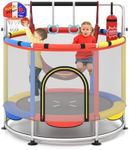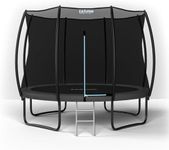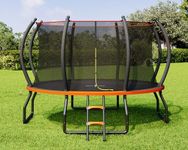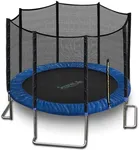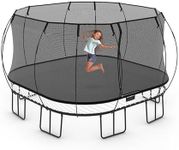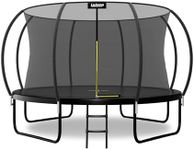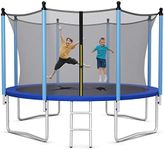Buying Guide for the Best Backyard Trampolines
Choosing the right backyard trampoline can make a big difference in safety, fun, and how well it fits your space and needs. Before you buy, think about who will be using the trampoline, how much space you have in your yard, and what features matter most to you, such as safety, durability, and ease of setup. Understanding the key specifications will help you make a choice that keeps everyone happy and safe.Size (Diameter)The size of a trampoline, usually measured in feet across the diameter, determines how much jumping space you have. This is important because a larger trampoline can accommodate more users or allow for bigger jumps, while a smaller one fits better in compact yards. Trampolines typically range from about 8 feet (good for young kids or small spaces), to 12-14 feet (a popular middle ground for families), up to 15 feet or more (best for teens, adults, or multiple users). To pick the right size, measure your available yard space and consider who will be using it most often—smaller sizes for young children and larger sizes for older kids or group play.
Weight LimitThe weight limit tells you the maximum combined weight the trampoline can safely support. This is crucial for safety, as exceeding the limit can damage the trampoline or cause injuries. Weight limits can range from around 150 pounds (suitable for young children) to over 400 pounds (for adults or multiple users). Choose a trampoline with a weight limit that matches the heaviest expected user or the total weight of people who might use it at the same time.
ShapeTrampolines come in different shapes, such as round, rectangular, oval, and square. The shape affects bounce quality and how the trampoline fits in your yard. Round trampolines are most common and tend to pull jumpers toward the center, making them safer for kids. Rectangular trampolines offer a more even bounce and are preferred for gymnastics or tricks, but they take up more space. Oval and square trampolines offer a compromise between the two. Pick a shape based on your yard layout and how you plan to use the trampoline.
Safety EnclosureA safety enclosure is a net that surrounds the jumping area to prevent falls. This is a key safety feature, especially for children. Some trampolines come with high, tightly-woven enclosures, while others may have lower or looser nets. Look for an enclosure that is sturdy, has a secure entry, and attaches well to the frame. If safety is a top concern, especially for younger users, always choose a trampoline with a high-quality enclosure.
Frame Material and ConstructionThe frame is the backbone of the trampoline, usually made from steel. The quality and thickness of the steel, as well as whether it is galvanized (coated to resist rust), affect how long the trampoline will last outdoors. Thicker, rust-resistant frames are more durable and safer, especially in areas with harsh weather. If you want a trampoline that lasts for years, look for strong, well-coated frames.
Spring Type and PaddingSprings provide the bounce, and their length, number, and quality affect how soft or firm the trampoline feels. More or longer springs usually mean a smoother, higher bounce. Padding covers the springs and frame to prevent injuries. Thick, weather-resistant padding is important for safety and comfort. If you have young children or want extra safety, prioritize trampolines with good spring padding.
Assembly and MaintenanceSome trampolines are easier to assemble than others, with clear instructions and fewer parts. Maintenance includes checking for rust, tears, or loose bolts. If you prefer less hassle, look for trampolines known for easy setup and low maintenance needs. Consider how often you’re willing to check and care for your trampoline when making your choice.
